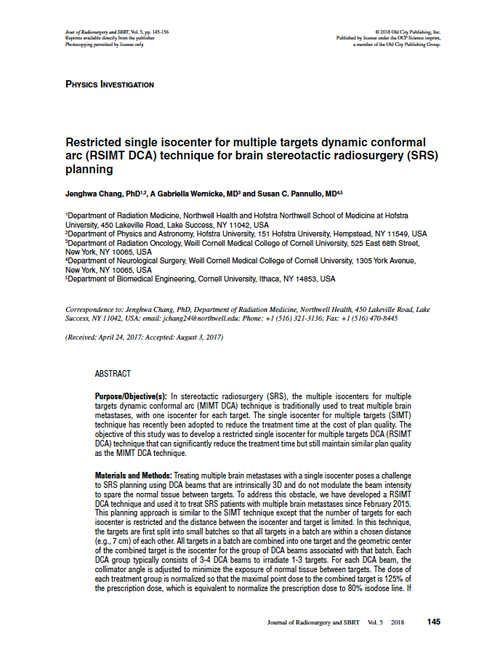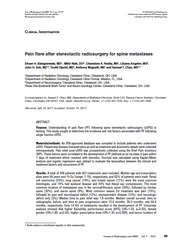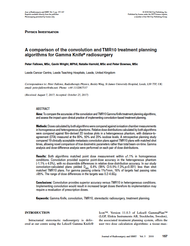- Home
- Journal Contents Downloads
- JRSBRT Downloads
- JRSBRT 5.2, 145-156
Product Description
Restricted single isocenter for multiple targets dynamic conformal arc (RSIMT DCA) technique for brain stereotactic radiosurgery (SRS) planning
Jenghwa Chang, A Gabriella Wernicke and Susan C. Pannullo
Purpose/Objective(s): In stereotactic radiosurgery (SRS), the multiple isocenters for multiple targets dynamic conformal arc (MIMT DCA) technique is traditionally used to treat multiple brain metastases, with one isocenter for each target. The single isocenter for multiple targets (SIMT) technique has recently been adopted to reduce the treatment time at the cost of plan quality. The objective of this study was to develop a restricted single isocenter for multiple targets DCA (RSIMT DCA) technique that can significantly reduce the treatment time but still maintain similar plan quality as the MIMT DCA technique.
Materials and Methods: Treating multiple brain metastases with a single isocenter poses a challenge to SRS planning using DCA beams that are intrinsically 3D and do not modulate the beam intensity to spare the normal tissue between targets. To address this obstacle, we have developed a RSIMT DCA technique and used it to treat SRS patients with multiple brain metastases since February 2015. This planning approach is similar to the SIMT technique except that the number of targets for each isocenter is restricted and the distance between the isocenter and target is limited. In this technique, the targets are first split into small batches so that all targets in a batch are within a chosen distance (e.g., 7 cm) of each other. All targets in a batch are combined into one target and the geometric center of the combined target is the isocenter for the group of DCA beams associated with that batch. Each DCA group typically consists of 3-4 DCA beams to irradiate 1-3 targets. For each DCA beam, the collimator angle is adjusted to minimize the exposure of normal tissue between targets. The dose of each treatment group is normalized so that the maximal point dose to the combined target is 125% of the prescription dose, which is equivalent to normalize the prescription dose to 80% isodose line. If the maximal point dose of a target is <123%, an additional beam is used to boost the maximal point dose of that target to 125%. To evaluate the plan quality, we randomly selected 10 cases planned with the RSIMT DCA technique, and re-planned them using the MIMT DCA technique. There were in total 38 PTVs, and 22 isocenters were used to treat all of these targets. The prescription for each target was 20 Gy with a maximal point dose of 25 Gy. Plan quality indexes were calculated and compared. Paired sample t-test was performed to determine if the mean normalized difference, (RSIMT-MIMT)/MIMT of each plan index was statistically significantly (p-value < 5%) larger than 0.
Results: Satisfactory PTV coverage (V20Gy>95% and V19Gy=100%) was achieved for all plans using either technique. Most PTVs have a maximal point dose between 24.9 and 25.1 Gy, with 2 PTVs between 24.5 and 24.9 Gy. Overall, the plan quality was slightly better for the MIMT DCA technique and the normalized difference was statistically significantly larger than 0 for all investigated dose quality indexes. The normalized difference of body mean dose and conformity index (CI) between the RSIMT and MIMT techniques was respectively 4.2% (p=0.002) and 9.4% (p=0.001), indicating similar plan quality globally and in the high dose area. The difference was more pronounced for the mid-to-low dose spillage with the ratios of V12Gy and V10Gy/VPTV being 13.9% (p=3.8×10-6) and 14.9% (p=1.3×10-5), respectively. The treatment time was reduced by 30%-50% with the RSIMT DCA technique.
Conclusion: The RSIMT DCA technique can produce satisfactory SRS plans for treating multiple targets and can significantly reduce the treatment time.
Keywords: single isocenter for multiple targets, multiple isocenters for multiple targets, dynamic conformal arc, rotational error
After payment has been processed for your order of a digital copy (PDF) of this article, you will see a download link on your completed order page and also receive an email containing a download link. The links, which will enable you to download one copy of the article, will expire after 24 hours.
 Loading... Please wait...
Loading... Please wait...








